Abstract
The relationship between an unstable argG gene and a 5.7-kilobase (kb) amplifiable DNA sequence in Streptomyces lividans 66 was investigated. Spontaneous, high-frequency Arg mutants deleted for this gene typically contain 200 to 300 copies of the tandemly reiterated sequence. A library of S. lividans 66 (strain 1326) wild-type genomic DNA was prepared in the vector lambda Charon 35. Chromosome walking over 44 kb established that argG is located 25 kb distant from a duplicated amplifiable DNA structure. A sequence was characterized, located farther distal from the amplifiable structure, containing strong homology with an internal sequence of the amplifiable DNA, which may have a role in the deletion of argG. Genetic mapping showed that argG and the 5.7-kb amplifiable sequence are linked to another unstable gene, determining chloramphenicol resistance (Camr) and that together these genes may be located in a silent chromosomal arc.
Full text
PDF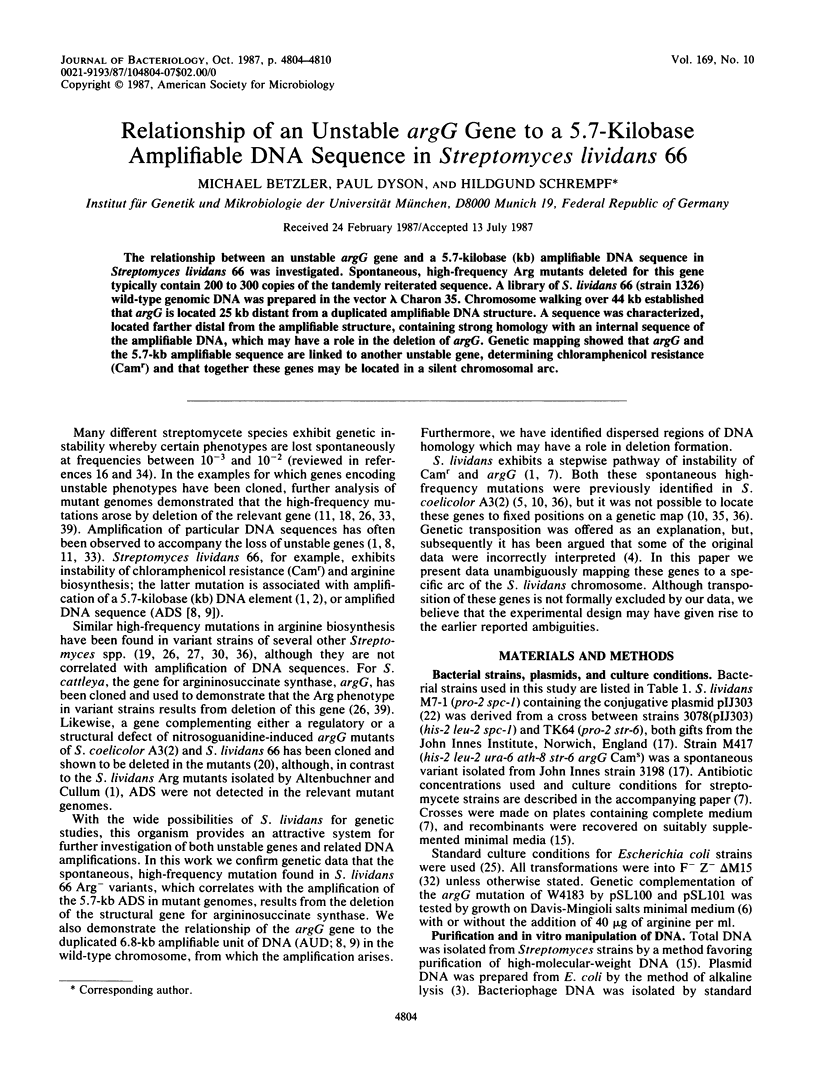
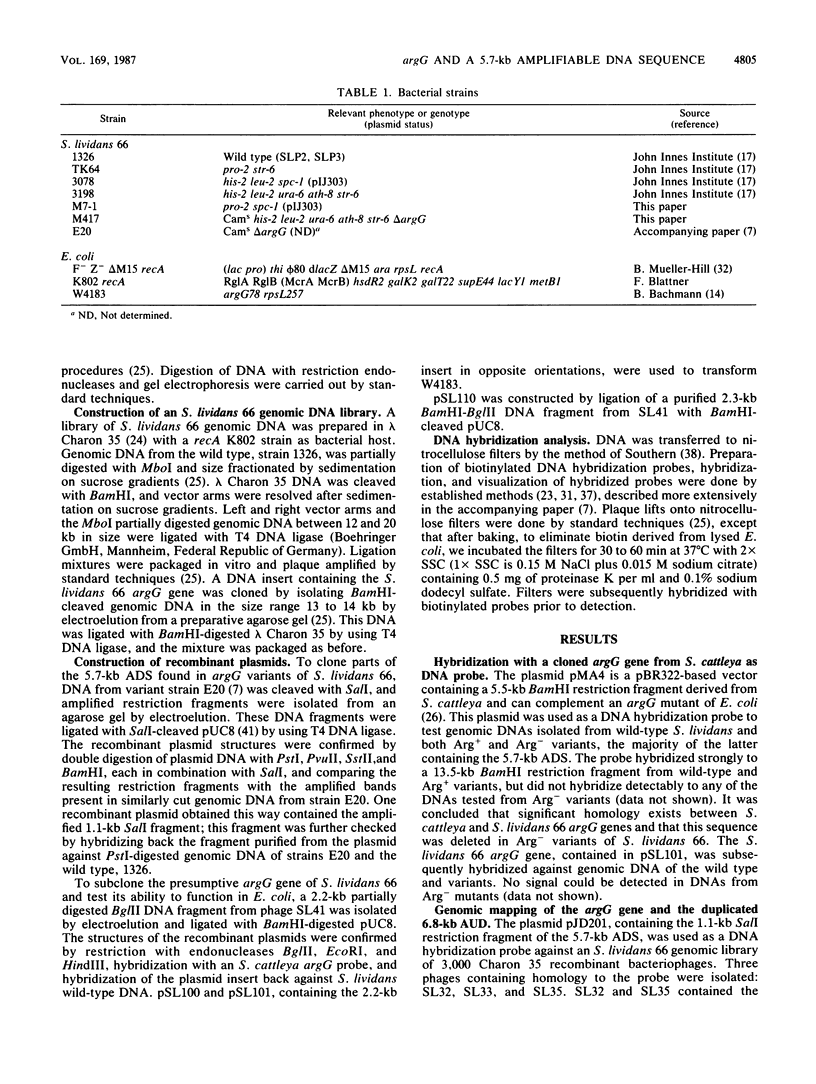

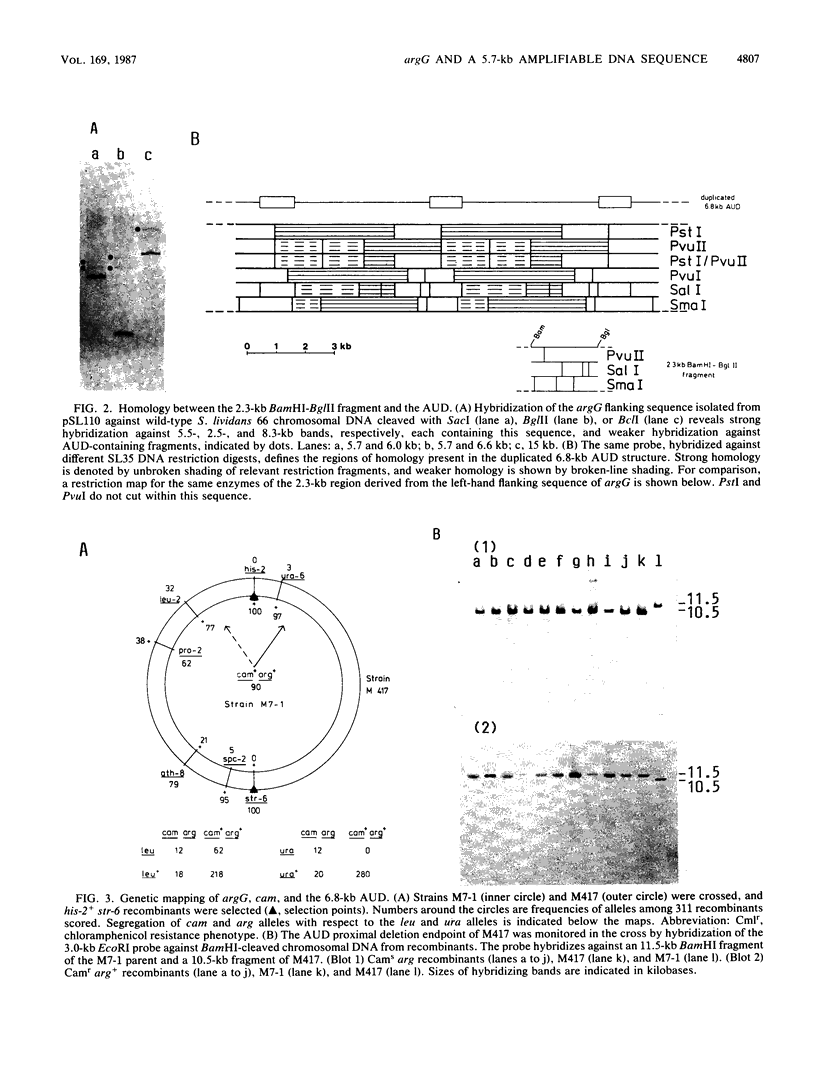
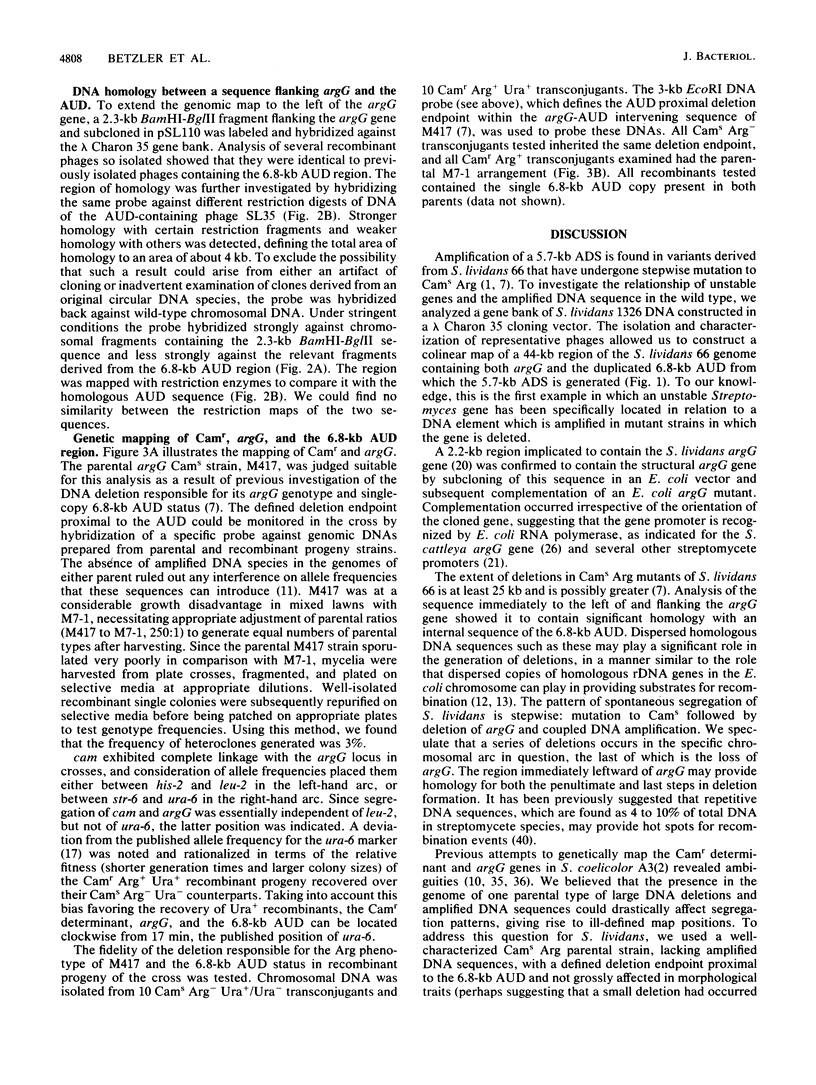
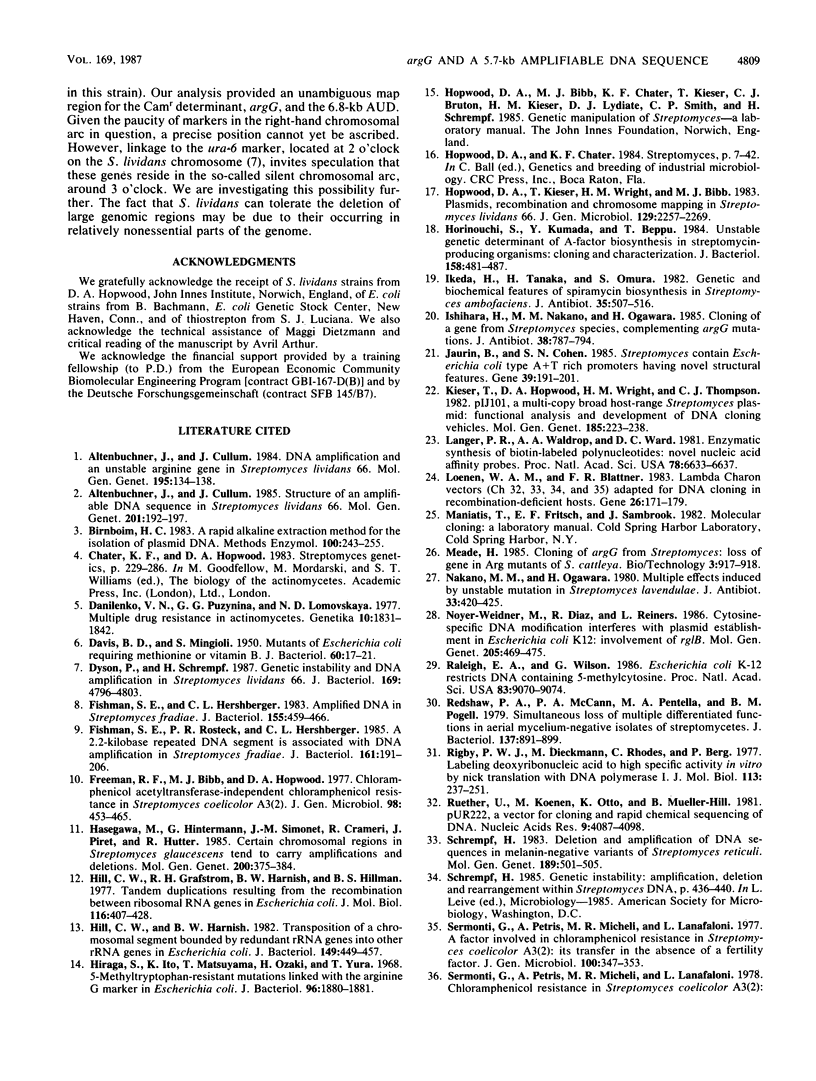
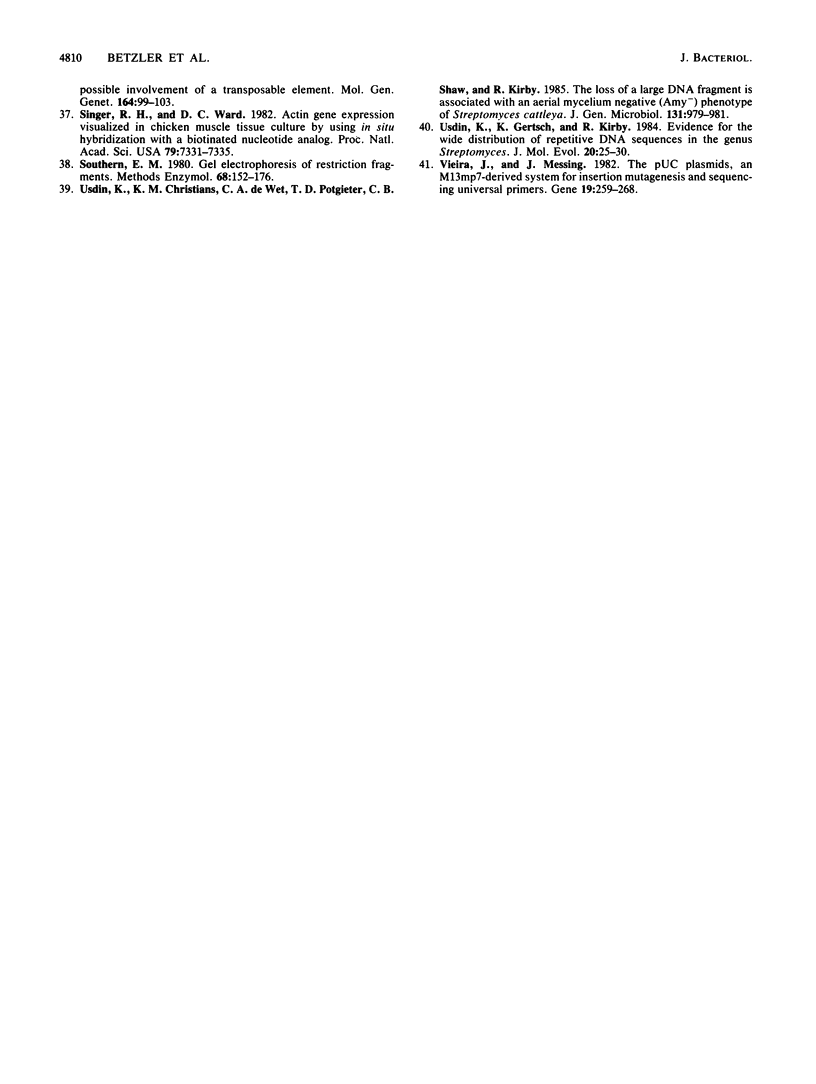
Images in this article
Selected References
These references are in PubMed. This may not be the complete list of references from this article.
- Altenbuchner J., Cullum J. DNA amplification and an unstable arginine gene in Streptomyces lividans 66. Mol Gen Genet. 1984;195(1-2):134–138. doi: 10.1007/BF00332735. [DOI] [PubMed] [Google Scholar]
- Altenbuchner J., Cullum J. Structure of an amplifiable DNA sequence in Streptomyces lividans 66. Mol Gen Genet. 1985;201(2):192–197. doi: 10.1007/BF00425659. [DOI] [PubMed] [Google Scholar]
- Birnboim H. C. A rapid alkaline extraction method for the isolation of plasmid DNA. Methods Enzymol. 1983;100:243–255. doi: 10.1016/0076-6879(83)00059-2. [DOI] [PubMed] [Google Scholar]
- DAVIS B. D., MINGIOLI E. S. Mutants of Escherichia coli requiring methionine or vitamin B12. J Bacteriol. 1950 Jul;60(1):17–28. doi: 10.1128/jb.60.1.17-28.1950. [DOI] [PMC free article] [PubMed] [Google Scholar]
- Danilenko V. N., Puzynina G. G., Lomovskaia N. D. Mnozhestvennaia ustoichivost' k antibiotikam u aktinomitsetov. Genetika. 1977;13(10):1831–1842. [PubMed] [Google Scholar]
- Dyson P., Schrempf H. Genetic instability and DNA amplification in Streptomyces lividans 66. J Bacteriol. 1987 Oct;169(10):4796–4803. doi: 10.1128/jb.169.10.4796-4803.1987. [DOI] [PMC free article] [PubMed] [Google Scholar]
- Fishman S. E., Hershberger C. L. Amplified DNA in Streptomyces fradiae. J Bacteriol. 1983 Aug;155(2):459–466. doi: 10.1128/jb.155.2.459-466.1983. [DOI] [PMC free article] [PubMed] [Google Scholar]
- Fishman S. E., Rosteck P. R., Jr, Hershberger C. L. A 2.2-kilobase repeated DNA segment is associated with DNA amplification in Streptomyces fradiae. J Bacteriol. 1985 Jan;161(1):199–206. doi: 10.1128/jb.161.1.199-206.1985. [DOI] [PMC free article] [PubMed] [Google Scholar]
- Freeman R. F., Bibb M. J., Hopwood D. A. Chloramphenicol acetylransferase-independent chloramphenicol resistance in Streptomyces coelicolor A3(2). J Gen Microbiol. 1977 Feb;98(2):453–465. doi: 10.1099/00221287-98-2-453. [DOI] [PubMed] [Google Scholar]
- Hasegawa M., Hintermann G., Simonet J. M., Crameri R., Piret J., Hütter R. Certain chromosomal regions in Streptomyces glaucescens tend to carry amplifications and deletions. Mol Gen Genet. 1985;200(3):375–384. doi: 10.1007/BF00425720. [DOI] [PubMed] [Google Scholar]
- Hill C. W., Grafstrom R. H., Harnish B. W., Hillman B. S. Tandem duplications resulting from recombination between ribosomal RNA genes in Escherichia coli. J Mol Biol. 1977 Nov 5;116(3):407–428. doi: 10.1016/0022-2836(77)90077-8. [DOI] [PubMed] [Google Scholar]
- Hill C. W., Harnish B. W. Transposition of a chromosomal segment bounded by redundant rRNA genes into other rRNA genes in Escherichia coli. J Bacteriol. 1982 Feb;149(2):449–457. doi: 10.1128/jb.149.2.449-457.1982. [DOI] [PMC free article] [PubMed] [Google Scholar]
- Hiraga S., Ito K., Matsuyama T., Ozaki H., Yura T. 5-methyltryptophan-resistant mutations lniked with the arginine G marker in Escherichia coli. J Bacteriol. 1968 Nov;96(5):1880–1881. doi: 10.1128/jb.96.5.1880-1881.1968. [DOI] [PMC free article] [PubMed] [Google Scholar]
- Hopwood D. A., Kieser T., Wright H. M., Bibb M. J. Plasmids, recombination and chromosome mapping in Streptomyces lividans 66. J Gen Microbiol. 1983 Jul;129(7):2257–2269. doi: 10.1099/00221287-129-7-2257. [DOI] [PubMed] [Google Scholar]
- Horinouchi S., Kumada Y., Beppu T. Unstable genetic determinant of A-factor biosynthesis in streptomycin-producing organisms: cloning and characterization. J Bacteriol. 1984 May;158(2):481–487. doi: 10.1128/jb.158.2.481-487.1984. [DOI] [PMC free article] [PubMed] [Google Scholar]
- Ikeda H., Tanaka H., Omura S. Genetic and biochemical features of spiramycin biosynthesis in Streptomyces ambofaciens--curing, protoplast regeneration and plasmid transfer. J Antibiot (Tokyo) 1982 Apr;35(4):507–516. doi: 10.7164/antibiotics.35.507. [DOI] [PubMed] [Google Scholar]
- Ishihara H., Nakano M. M., Ogawara H. Cloning of a gene from Streptomyces species complementing argG mutations. J Antibiot (Tokyo) 1985 Jun;38(6):787–794. doi: 10.7164/antibiotics.38.787. [DOI] [PubMed] [Google Scholar]
- Jaurin B., Cohen S. N. Streptomyces contain Escherichia coli-type A + T-rich promoters having novel structural features. Gene. 1985;39(2-3):191–201. doi: 10.1016/0378-1119(85)90313-0. [DOI] [PubMed] [Google Scholar]
- Kieser T., Hopwood D. A., Wright H. M., Thompson C. J. pIJ101, a multi-copy broad host-range Streptomyces plasmid: functional analysis and development of DNA cloning vectors. Mol Gen Genet. 1982;185(2):223–228. doi: 10.1007/BF00330791. [DOI] [PubMed] [Google Scholar]
- Langer P. R., Waldrop A. A., Ward D. C. Enzymatic synthesis of biotin-labeled polynucleotides: novel nucleic acid affinity probes. Proc Natl Acad Sci U S A. 1981 Nov;78(11):6633–6637. doi: 10.1073/pnas.78.11.6633. [DOI] [PMC free article] [PubMed] [Google Scholar]
- Loenen W. A., Blattner F. R. Lambda Charon vectors (Ch32, 33, 34 and 35) adapted for DNA cloning in recombination-deficient hosts. Gene. 1983 Dec;26(2-3):171–179. doi: 10.1016/0378-1119(83)90187-7. [DOI] [PubMed] [Google Scholar]
- Nakano M. M., Ogawara H. Multiple effects induced by unstable mutation in Streptomyces lavendulae. J Antibiot (Tokyo) 1980 Apr;33(4):420–425. doi: 10.7164/antibiotics.33.420. [DOI] [PubMed] [Google Scholar]
- Noyer-Weidner M., Diaz R., Reiners L. Cytosine-specific DNA modification interferes with plasmid establishment in Escherichia coli K12: involvement of rglB. Mol Gen Genet. 1986 Dec;205(3):469–475. doi: 10.1007/BF00338084. [DOI] [PubMed] [Google Scholar]
- Raleigh E. A., Wilson G. Escherichia coli K-12 restricts DNA containing 5-methylcytosine. Proc Natl Acad Sci U S A. 1986 Dec;83(23):9070–9074. doi: 10.1073/pnas.83.23.9070. [DOI] [PMC free article] [PubMed] [Google Scholar]
- Redshaw P. A., McCann P. A., Pentella M. A., Pogell B. M. Simultaneous loss of multiple differentiated functions in aerial mycelium-negative isolates of streptomycetes. J Bacteriol. 1979 Feb;137(2):891–899. doi: 10.1128/jb.137.2.891-899.1979. [DOI] [PMC free article] [PubMed] [Google Scholar]
- Rigby P. W., Dieckmann M., Rhodes C., Berg P. Labeling deoxyribonucleic acid to high specific activity in vitro by nick translation with DNA polymerase I. J Mol Biol. 1977 Jun 15;113(1):237–251. doi: 10.1016/0022-2836(77)90052-3. [DOI] [PubMed] [Google Scholar]
- Rüther U., Koenen M., Otto K., Müller-Hill B. pUR222, a vector for cloning and rapid chemical sequencing of DNA. Nucleic Acids Res. 1981 Aug 25;9(16):4087–4098. doi: 10.1093/nar/9.16.4087. [DOI] [PMC free article] [PubMed] [Google Scholar]
- Schrempf H. Deletion and amplification of DNA sequences in melanin-negative variants of Streptomyces reticuli. Mol Gen Genet. 1983;189(3):501–505. doi: 10.1007/BF00325917. [DOI] [PubMed] [Google Scholar]
- Sermonti G., Petris A., Micheli M., Lanfaloni L. A factor involved in chloramphenicol resistance in Streptomyces coelicolor A3(2): its transfer in the absence of the fertility factor. J Gen Microbiol. 1977 Jun;100(2):347–353. doi: 10.1099/00221287-100-2-347. [DOI] [PubMed] [Google Scholar]
- Singer R. H., Ward D. C. Actin gene expression visualized in chicken muscle tissue culture by using in situ hybridization with a biotinated nucleotide analog. Proc Natl Acad Sci U S A. 1982 Dec;79(23):7331–7335. doi: 10.1073/pnas.79.23.7331. [DOI] [PMC free article] [PubMed] [Google Scholar]
- Southern E. Gel electrophoresis of restriction fragments. Methods Enzymol. 1979;68:152–176. doi: 10.1016/0076-6879(79)68011-4. [DOI] [PubMed] [Google Scholar]
- Usdin K., Christians K. M., de Wet C. A., Potgieter T. D., Shaw C. B., Kirby R. The loss of a large DNA fragment is associated with an aerial mycelium negative (Amy-) phenotype of Streptomyces cattleya. J Gen Microbiol. 1985 Apr;131(4):979–981. doi: 10.1099/00221287-131-4-979. [DOI] [PubMed] [Google Scholar]
- Usdin K., Gertsch K., Kirby R. Evidence for the wide distribution of repetitive DNA sequences in the genus Streptomyces. J Mol Evol. 1984;20(1):25–30. doi: 10.1007/BF02101982. [DOI] [PubMed] [Google Scholar]
- Vieira J., Messing J. The pUC plasmids, an M13mp7-derived system for insertion mutagenesis and sequencing with synthetic universal primers. Gene. 1982 Oct;19(3):259–268. doi: 10.1016/0378-1119(82)90015-4. [DOI] [PubMed] [Google Scholar]




